Change Management Project: BizOps Enterprise - Business Development
VerifiedAdded on 2023/06/04
|7
|1400
|371
Project
AI Summary
This project analyzes the need for change management at BizOps Enterprise, identifying issues such as frequent management changes, lack of training, and outdated vision statements. It includes a risk analysis, evaluating the impact of identified risks and assessing change readiness through interviews and surveys. The project utilizes force field analysis to identify driving and restraining forces, and proposes strategies like implementing training programs and adopting new technologies. The project aims to improve performance and competitiveness of the company by addressing internal issues and adapting to market changes. The project provides a comprehensive overview of the challenges faced by BizOps Enterprise and suggests actionable steps to improve its performance and market position.
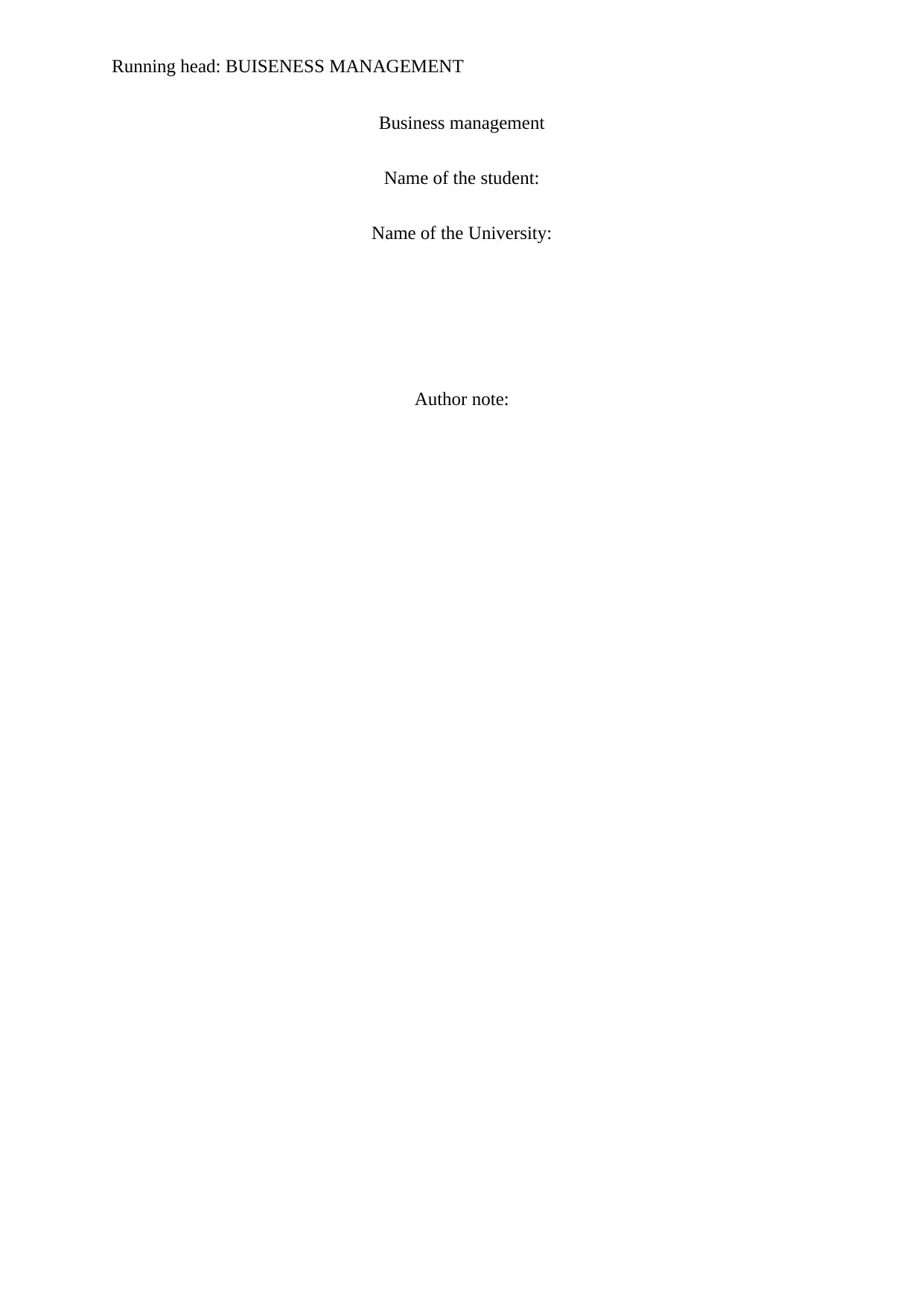
Running head: BUISENESS MANAGEMENT
Business management
Name of the student:
Name of the University:
Author note:
Business management
Name of the student:
Name of the University:
Author note:
Paraphrase This Document
Need a fresh take? Get an instant paraphrase of this document with our AI Paraphraser
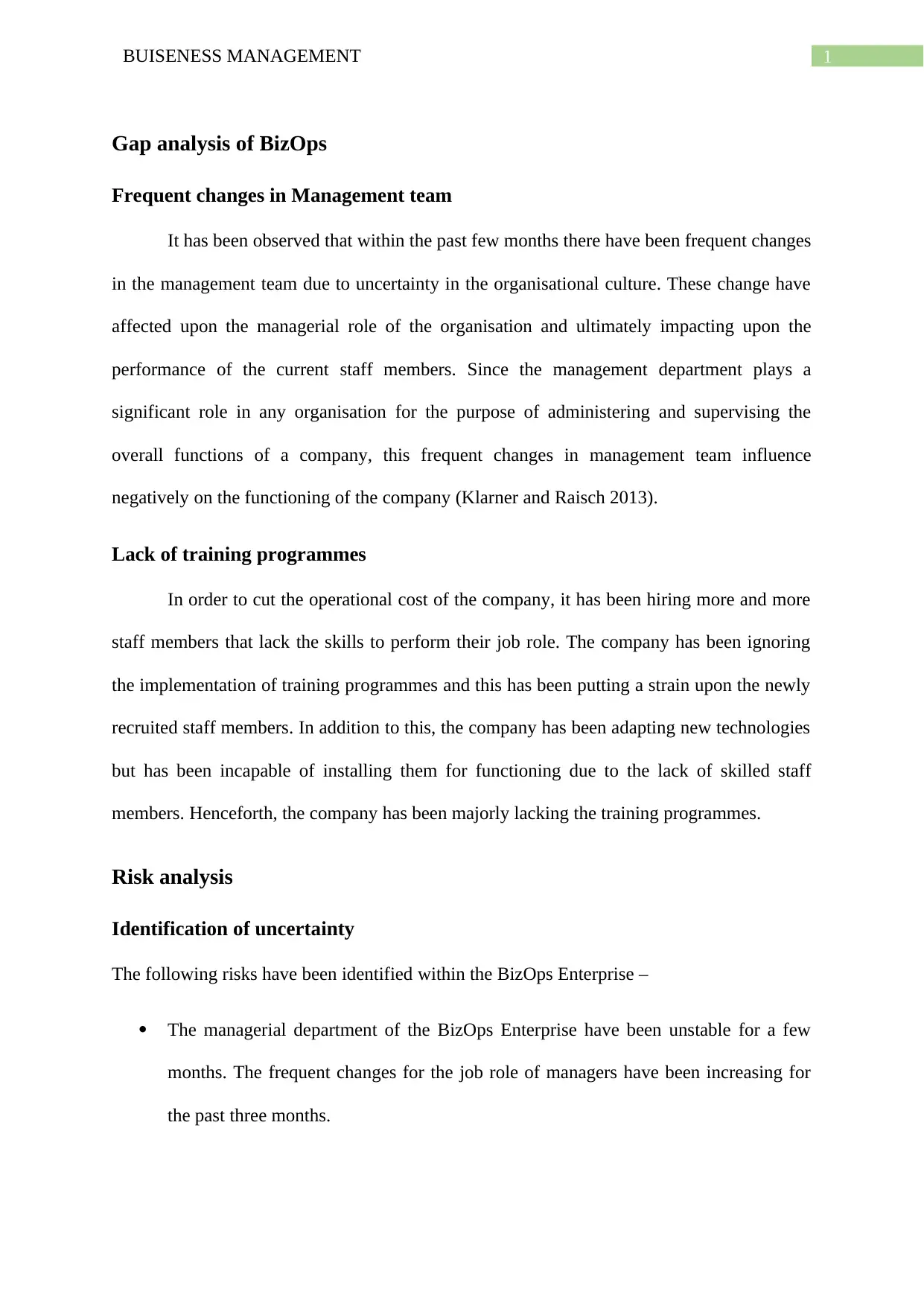
1BUISENESS MANAGEMENT
Gap analysis of BizOps
Frequent changes in Management team
It has been observed that within the past few months there have been frequent changes
in the management team due to uncertainty in the organisational culture. These change have
affected upon the managerial role of the organisation and ultimately impacting upon the
performance of the current staff members. Since the management department plays a
significant role in any organisation for the purpose of administering and supervising the
overall functions of a company, this frequent changes in management team influence
negatively on the functioning of the company (Klarner and Raisch 2013).
Lack of training programmes
In order to cut the operational cost of the company, it has been hiring more and more
staff members that lack the skills to perform their job role. The company has been ignoring
the implementation of training programmes and this has been putting a strain upon the newly
recruited staff members. In addition to this, the company has been adapting new technologies
but has been incapable of installing them for functioning due to the lack of skilled staff
members. Henceforth, the company has been majorly lacking the training programmes.
Risk analysis
Identification of uncertainty
The following risks have been identified within the BizOps Enterprise –
The managerial department of the BizOps Enterprise have been unstable for a few
months. The frequent changes for the job role of managers have been increasing for
the past three months.
Gap analysis of BizOps
Frequent changes in Management team
It has been observed that within the past few months there have been frequent changes
in the management team due to uncertainty in the organisational culture. These change have
affected upon the managerial role of the organisation and ultimately impacting upon the
performance of the current staff members. Since the management department plays a
significant role in any organisation for the purpose of administering and supervising the
overall functions of a company, this frequent changes in management team influence
negatively on the functioning of the company (Klarner and Raisch 2013).
Lack of training programmes
In order to cut the operational cost of the company, it has been hiring more and more
staff members that lack the skills to perform their job role. The company has been ignoring
the implementation of training programmes and this has been putting a strain upon the newly
recruited staff members. In addition to this, the company has been adapting new technologies
but has been incapable of installing them for functioning due to the lack of skilled staff
members. Henceforth, the company has been majorly lacking the training programmes.
Risk analysis
Identification of uncertainty
The following risks have been identified within the BizOps Enterprise –
The managerial department of the BizOps Enterprise have been unstable for a few
months. The frequent changes for the job role of managers have been increasing for
the past three months.
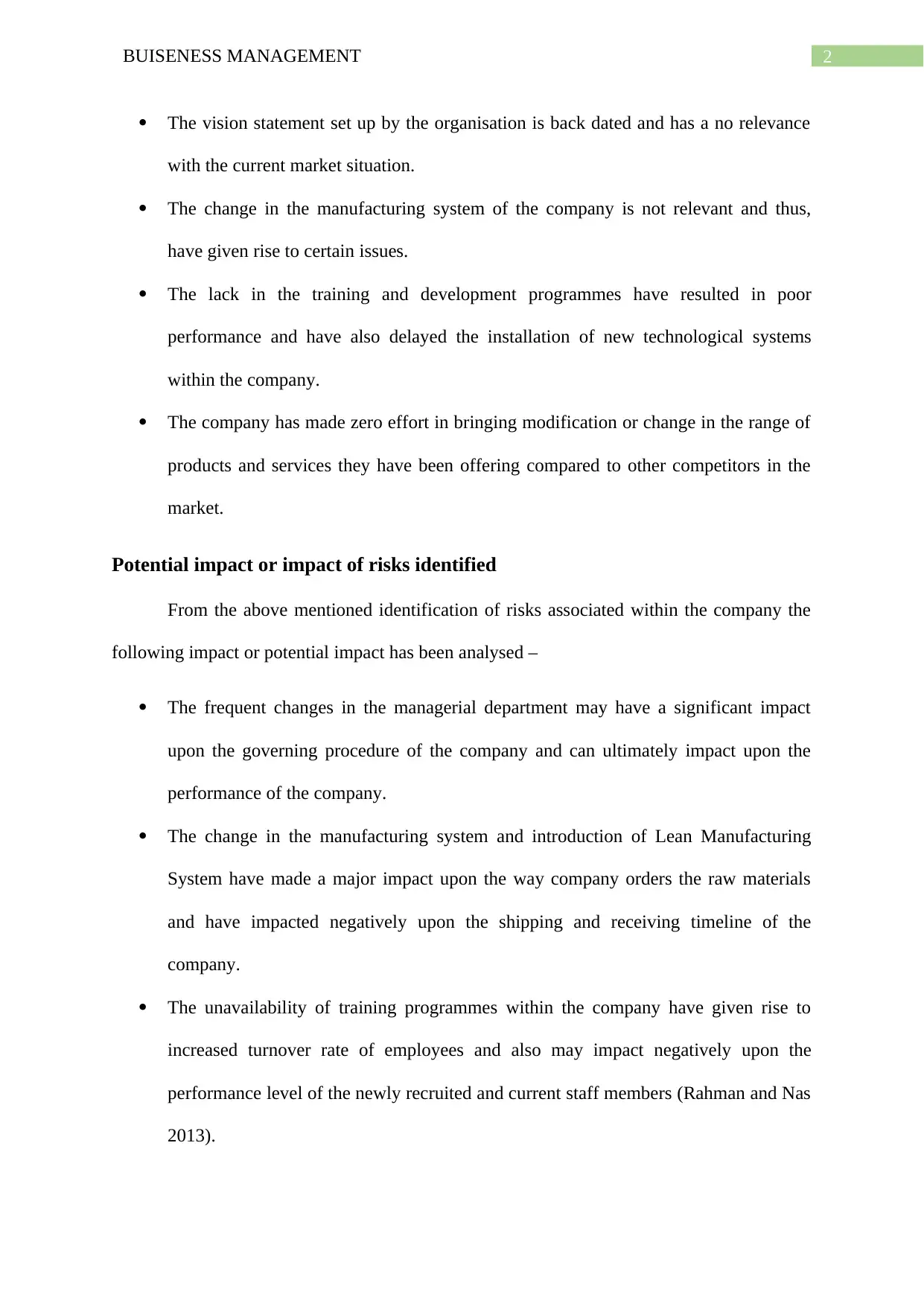
2BUISENESS MANAGEMENT
The vision statement set up by the organisation is back dated and has a no relevance
with the current market situation.
The change in the manufacturing system of the company is not relevant and thus,
have given rise to certain issues.
The lack in the training and development programmes have resulted in poor
performance and have also delayed the installation of new technological systems
within the company.
The company has made zero effort in bringing modification or change in the range of
products and services they have been offering compared to other competitors in the
market.
Potential impact or impact of risks identified
From the above mentioned identification of risks associated within the company the
following impact or potential impact has been analysed –
The frequent changes in the managerial department may have a significant impact
upon the governing procedure of the company and can ultimately impact upon the
performance of the company.
The change in the manufacturing system and introduction of Lean Manufacturing
System have made a major impact upon the way company orders the raw materials
and have impacted negatively upon the shipping and receiving timeline of the
company.
The unavailability of training programmes within the company have given rise to
increased turnover rate of employees and also may impact negatively upon the
performance level of the newly recruited and current staff members (Rahman and Nas
2013).
The vision statement set up by the organisation is back dated and has a no relevance
with the current market situation.
The change in the manufacturing system of the company is not relevant and thus,
have given rise to certain issues.
The lack in the training and development programmes have resulted in poor
performance and have also delayed the installation of new technological systems
within the company.
The company has made zero effort in bringing modification or change in the range of
products and services they have been offering compared to other competitors in the
market.
Potential impact or impact of risks identified
From the above mentioned identification of risks associated within the company the
following impact or potential impact has been analysed –
The frequent changes in the managerial department may have a significant impact
upon the governing procedure of the company and can ultimately impact upon the
performance of the company.
The change in the manufacturing system and introduction of Lean Manufacturing
System have made a major impact upon the way company orders the raw materials
and have impacted negatively upon the shipping and receiving timeline of the
company.
The unavailability of training programmes within the company have given rise to
increased turnover rate of employees and also may impact negatively upon the
performance level of the newly recruited and current staff members (Rahman and Nas
2013).
⊘ This is a preview!⊘
Do you want full access?
Subscribe today to unlock all pages.

Trusted by 1+ million students worldwide
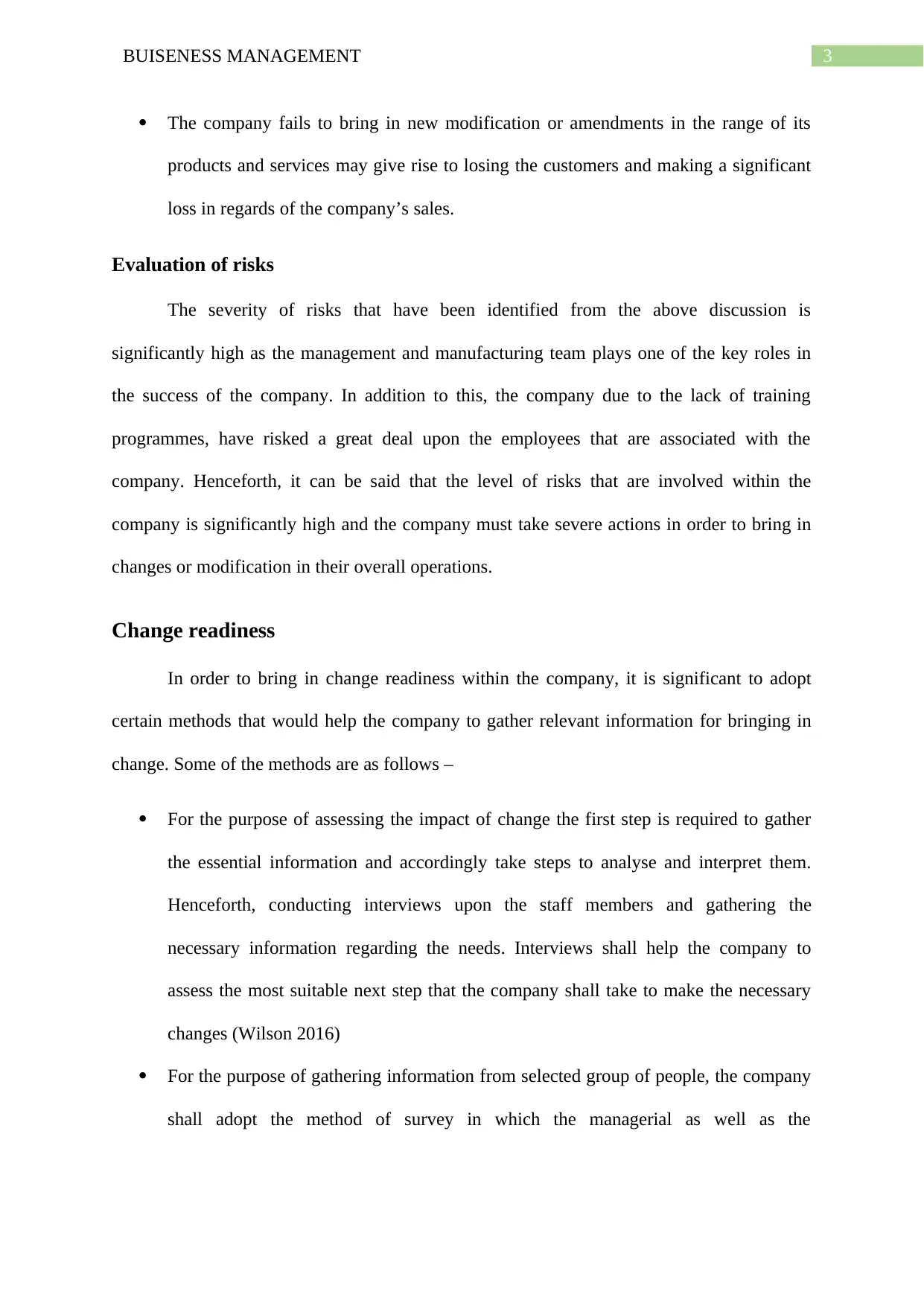
3BUISENESS MANAGEMENT
The company fails to bring in new modification or amendments in the range of its
products and services may give rise to losing the customers and making a significant
loss in regards of the company’s sales.
Evaluation of risks
The severity of risks that have been identified from the above discussion is
significantly high as the management and manufacturing team plays one of the key roles in
the success of the company. In addition to this, the company due to the lack of training
programmes, have risked a great deal upon the employees that are associated with the
company. Henceforth, it can be said that the level of risks that are involved within the
company is significantly high and the company must take severe actions in order to bring in
changes or modification in their overall operations.
Change readiness
In order to bring in change readiness within the company, it is significant to adopt
certain methods that would help the company to gather relevant information for bringing in
change. Some of the methods are as follows –
For the purpose of assessing the impact of change the first step is required to gather
the essential information and accordingly take steps to analyse and interpret them.
Henceforth, conducting interviews upon the staff members and gathering the
necessary information regarding the needs. Interviews shall help the company to
assess the most suitable next step that the company shall take to make the necessary
changes (Wilson 2016)
For the purpose of gathering information from selected group of people, the company
shall adopt the method of survey in which the managerial as well as the
The company fails to bring in new modification or amendments in the range of its
products and services may give rise to losing the customers and making a significant
loss in regards of the company’s sales.
Evaluation of risks
The severity of risks that have been identified from the above discussion is
significantly high as the management and manufacturing team plays one of the key roles in
the success of the company. In addition to this, the company due to the lack of training
programmes, have risked a great deal upon the employees that are associated with the
company. Henceforth, it can be said that the level of risks that are involved within the
company is significantly high and the company must take severe actions in order to bring in
changes or modification in their overall operations.
Change readiness
In order to bring in change readiness within the company, it is significant to adopt
certain methods that would help the company to gather relevant information for bringing in
change. Some of the methods are as follows –
For the purpose of assessing the impact of change the first step is required to gather
the essential information and accordingly take steps to analyse and interpret them.
Henceforth, conducting interviews upon the staff members and gathering the
necessary information regarding the needs. Interviews shall help the company to
assess the most suitable next step that the company shall take to make the necessary
changes (Wilson 2016)
For the purpose of gathering information from selected group of people, the company
shall adopt the method of survey in which the managerial as well as the
Paraphrase This Document
Need a fresh take? Get an instant paraphrase of this document with our AI Paraphraser
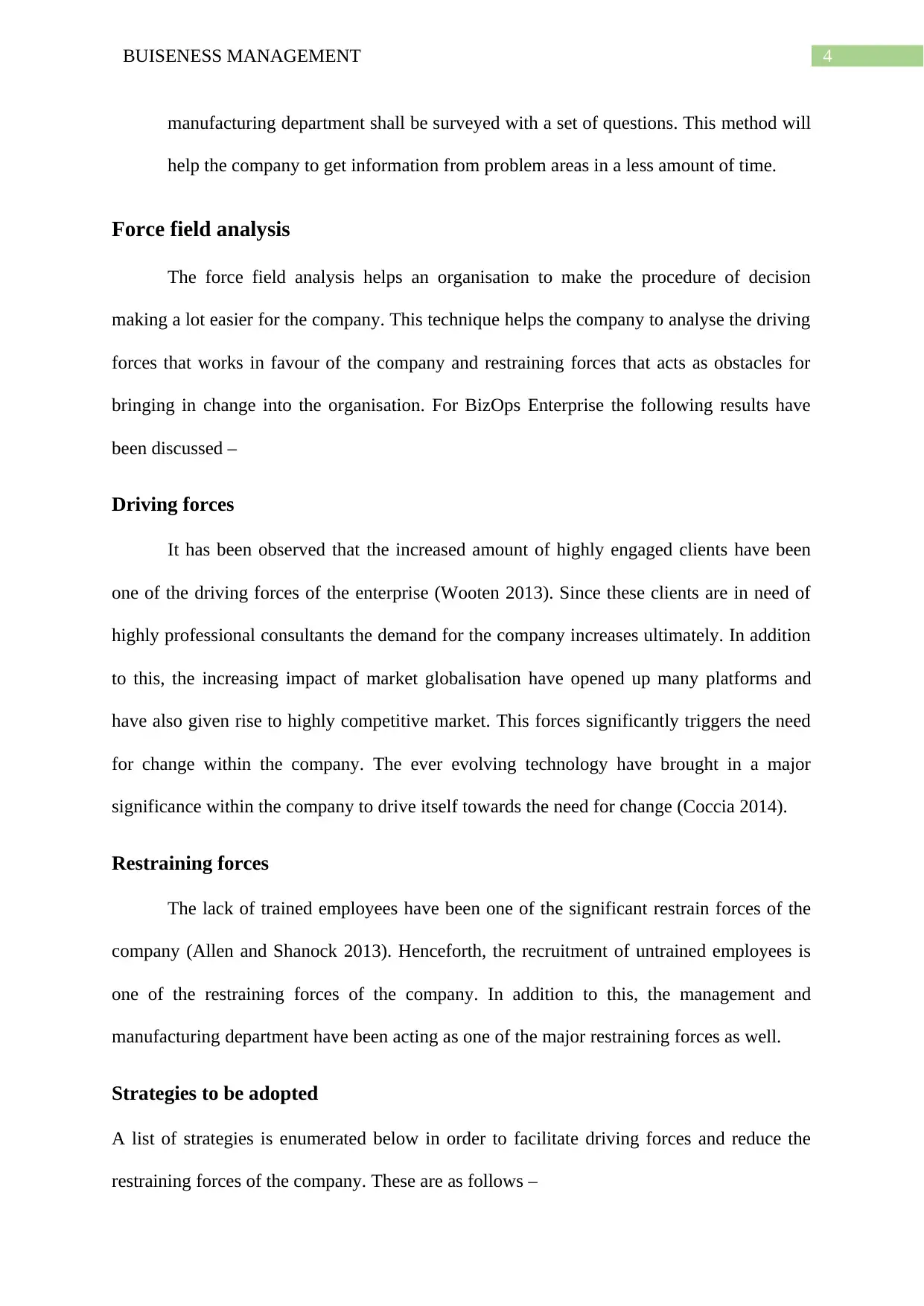
4BUISENESS MANAGEMENT
manufacturing department shall be surveyed with a set of questions. This method will
help the company to get information from problem areas in a less amount of time.
Force field analysis
The force field analysis helps an organisation to make the procedure of decision
making a lot easier for the company. This technique helps the company to analyse the driving
forces that works in favour of the company and restraining forces that acts as obstacles for
bringing in change into the organisation. For BizOps Enterprise the following results have
been discussed –
Driving forces
It has been observed that the increased amount of highly engaged clients have been
one of the driving forces of the enterprise (Wooten 2013). Since these clients are in need of
highly professional consultants the demand for the company increases ultimately. In addition
to this, the increasing impact of market globalisation have opened up many platforms and
have also given rise to highly competitive market. This forces significantly triggers the need
for change within the company. The ever evolving technology have brought in a major
significance within the company to drive itself towards the need for change (Coccia 2014).
Restraining forces
The lack of trained employees have been one of the significant restrain forces of the
company (Allen and Shanock 2013). Henceforth, the recruitment of untrained employees is
one of the restraining forces of the company. In addition to this, the management and
manufacturing department have been acting as one of the major restraining forces as well.
Strategies to be adopted
A list of strategies is enumerated below in order to facilitate driving forces and reduce the
restraining forces of the company. These are as follows –
manufacturing department shall be surveyed with a set of questions. This method will
help the company to get information from problem areas in a less amount of time.
Force field analysis
The force field analysis helps an organisation to make the procedure of decision
making a lot easier for the company. This technique helps the company to analyse the driving
forces that works in favour of the company and restraining forces that acts as obstacles for
bringing in change into the organisation. For BizOps Enterprise the following results have
been discussed –
Driving forces
It has been observed that the increased amount of highly engaged clients have been
one of the driving forces of the enterprise (Wooten 2013). Since these clients are in need of
highly professional consultants the demand for the company increases ultimately. In addition
to this, the increasing impact of market globalisation have opened up many platforms and
have also given rise to highly competitive market. This forces significantly triggers the need
for change within the company. The ever evolving technology have brought in a major
significance within the company to drive itself towards the need for change (Coccia 2014).
Restraining forces
The lack of trained employees have been one of the significant restrain forces of the
company (Allen and Shanock 2013). Henceforth, the recruitment of untrained employees is
one of the restraining forces of the company. In addition to this, the management and
manufacturing department have been acting as one of the major restraining forces as well.
Strategies to be adopted
A list of strategies is enumerated below in order to facilitate driving forces and reduce the
restraining forces of the company. These are as follows –
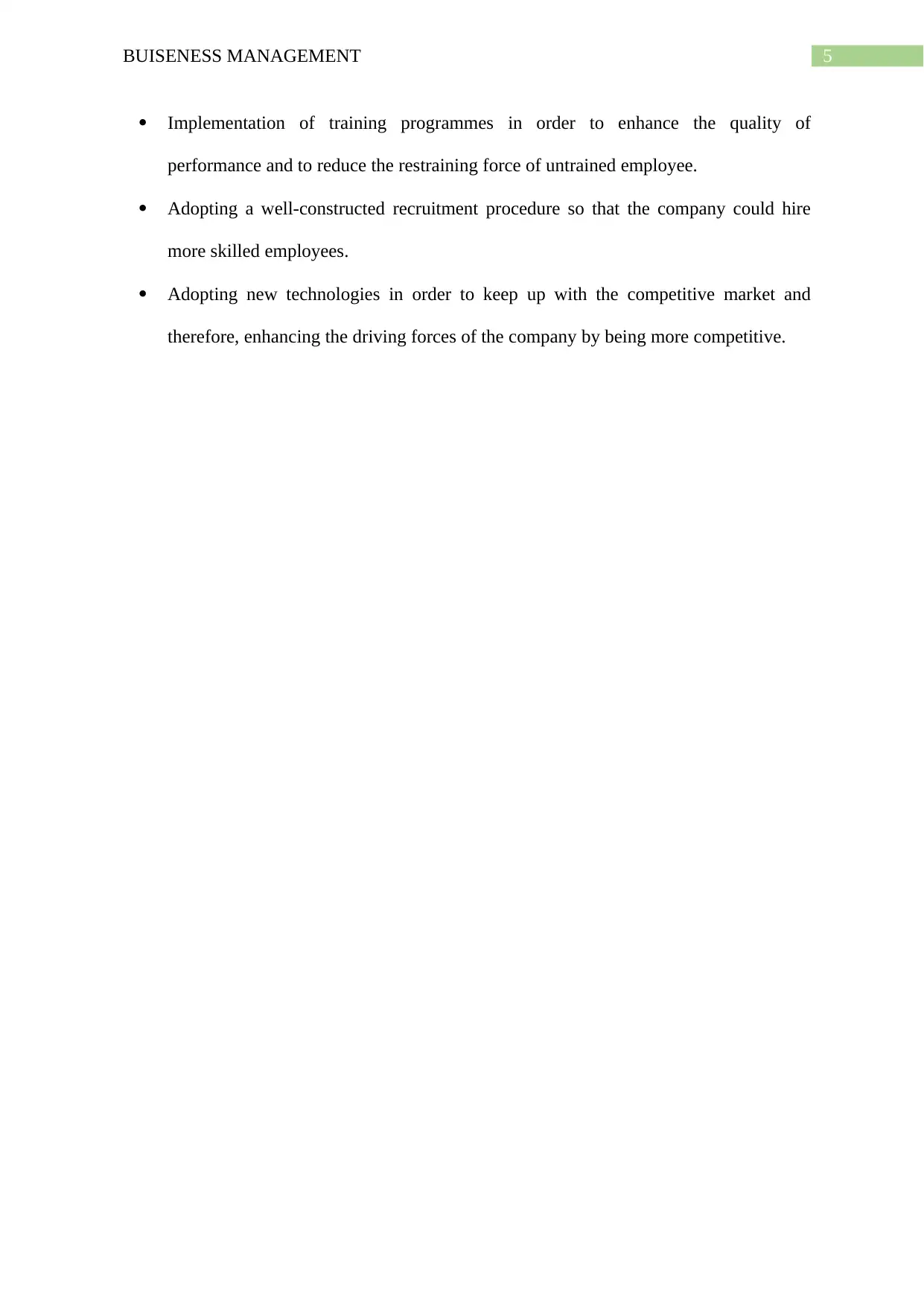
5BUISENESS MANAGEMENT
Implementation of training programmes in order to enhance the quality of
performance and to reduce the restraining force of untrained employee.
Adopting a well-constructed recruitment procedure so that the company could hire
more skilled employees.
Adopting new technologies in order to keep up with the competitive market and
therefore, enhancing the driving forces of the company by being more competitive.
Implementation of training programmes in order to enhance the quality of
performance and to reduce the restraining force of untrained employee.
Adopting a well-constructed recruitment procedure so that the company could hire
more skilled employees.
Adopting new technologies in order to keep up with the competitive market and
therefore, enhancing the driving forces of the company by being more competitive.
⊘ This is a preview!⊘
Do you want full access?
Subscribe today to unlock all pages.

Trusted by 1+ million students worldwide
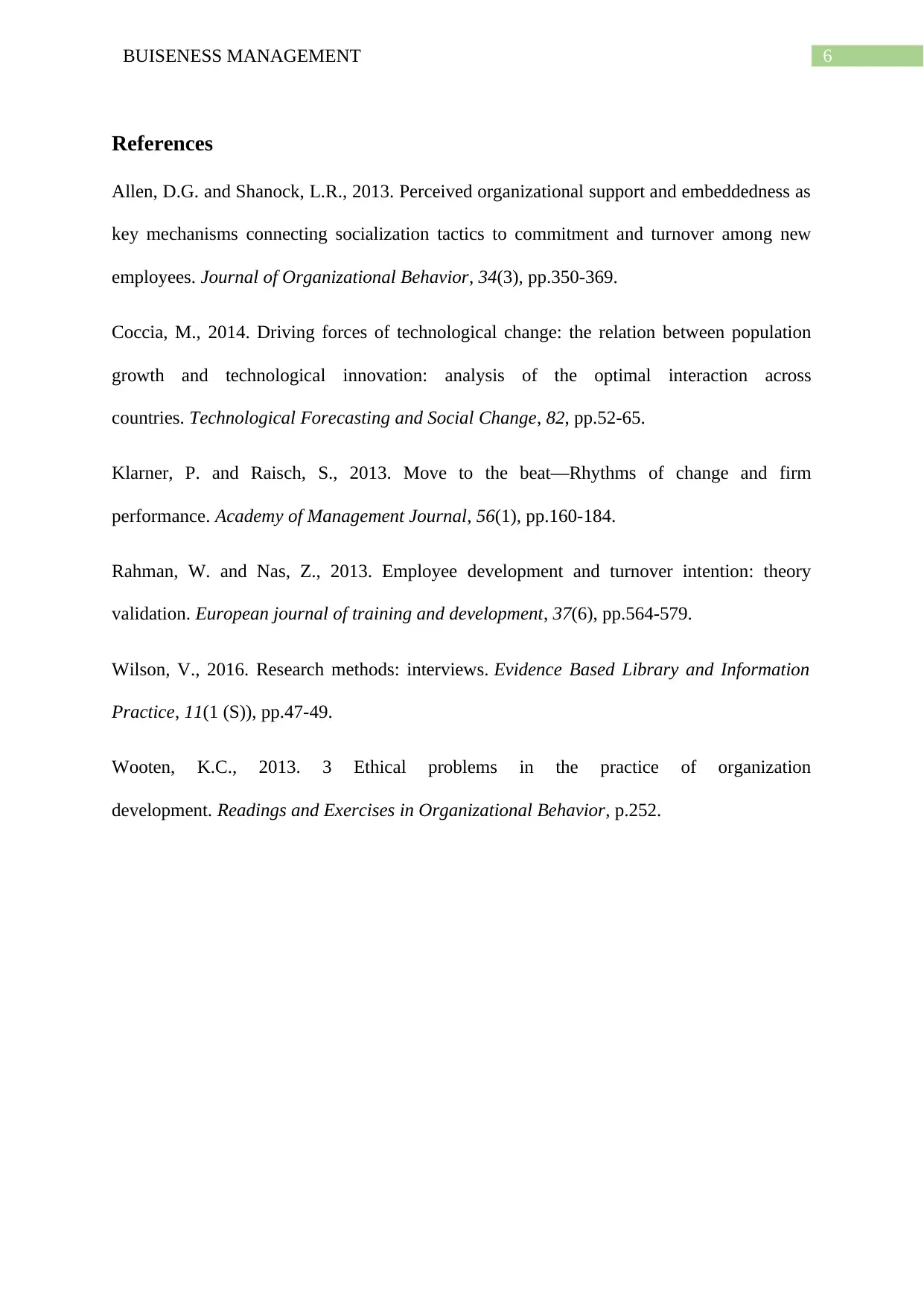
6BUISENESS MANAGEMENT
References
Allen, D.G. and Shanock, L.R., 2013. Perceived organizational support and embeddedness as
key mechanisms connecting socialization tactics to commitment and turnover among new
employees. Journal of Organizational Behavior, 34(3), pp.350-369.
Coccia, M., 2014. Driving forces of technological change: the relation between population
growth and technological innovation: analysis of the optimal interaction across
countries. Technological Forecasting and Social Change, 82, pp.52-65.
Klarner, P. and Raisch, S., 2013. Move to the beat—Rhythms of change and firm
performance. Academy of Management Journal, 56(1), pp.160-184.
Rahman, W. and Nas, Z., 2013. Employee development and turnover intention: theory
validation. European journal of training and development, 37(6), pp.564-579.
Wilson, V., 2016. Research methods: interviews. Evidence Based Library and Information
Practice, 11(1 (S)), pp.47-49.
Wooten, K.C., 2013. 3 Ethical problems in the practice of organization
development. Readings and Exercises in Organizational Behavior, p.252.
References
Allen, D.G. and Shanock, L.R., 2013. Perceived organizational support and embeddedness as
key mechanisms connecting socialization tactics to commitment and turnover among new
employees. Journal of Organizational Behavior, 34(3), pp.350-369.
Coccia, M., 2014. Driving forces of technological change: the relation between population
growth and technological innovation: analysis of the optimal interaction across
countries. Technological Forecasting and Social Change, 82, pp.52-65.
Klarner, P. and Raisch, S., 2013. Move to the beat—Rhythms of change and firm
performance. Academy of Management Journal, 56(1), pp.160-184.
Rahman, W. and Nas, Z., 2013. Employee development and turnover intention: theory
validation. European journal of training and development, 37(6), pp.564-579.
Wilson, V., 2016. Research methods: interviews. Evidence Based Library and Information
Practice, 11(1 (S)), pp.47-49.
Wooten, K.C., 2013. 3 Ethical problems in the practice of organization
development. Readings and Exercises in Organizational Behavior, p.252.
1 out of 7
Related Documents
Your All-in-One AI-Powered Toolkit for Academic Success.
+13062052269
info@desklib.com
Available 24*7 on WhatsApp / Email
![[object Object]](/_next/static/media/star-bottom.7253800d.svg)
Unlock your academic potential
Copyright © 2020–2025 A2Z Services. All Rights Reserved. Developed and managed by ZUCOL.





